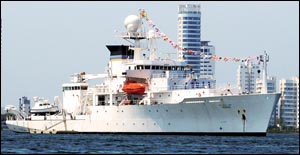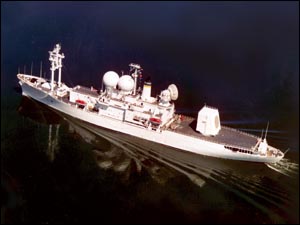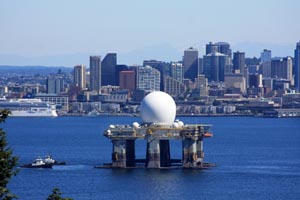 |
Military Sealift Command Special Mission |
|||||||||
|
||||||||||
|
Special Mission Military Sealift Command's Special Mission Program has 24 ships that provide operating platforms and services for a wide variety of U.S. military and other U.S. government missions. Oceanographic and hydrographic surveys, underwater surveillance, missile tracking, acoustic surveys, and submarine and special warfare support are just a few of the specialized services provided to:
Special mission ships are operated by civilian mariners who work for private companies under contract to MSC.
Submarine And Special Warfare Support Ships MSC operates eight chartered submarine and special warfare support ships for the Navy. Three ships support the Naval Special Warfare Command. Four other ships support the Navy's submarine escort requirements while entering and leaving ports.
Oceanographic Survey Ships MSC operates six oceanographic survey ships. These multipurpose ships perform acoustic, biological, physical and geophysical surveys, providing much of the U.S. military's information on the ocean environment. These ships use multi-beam, wide-angle, precision sonar systems that make it possible to continuously chart a broad section of ocean floor.
Ocean Surveillance Ships Five ocean surveillance ships directly support the Navy by using both passive and active low frequency sonar arrays to detect and track undersea threats.
Missile Range Instrumentation Ships MSC's three missile range instrumentation ships provide platforms for monitoring missile launches and collecting data that can be used to improve missile efficiency and accuracy. USNS Invincible, USNS Howard O. Lorenzen and USNS Observation Island monitor foreign missile and weapons tests that may pose potential threats to air or surface navigation. These ships also monitor domestic weapons systems tests to provide valuable feedback to U.S. weapons systems designers. Navigation Test Support Ship Navigation test support ship USNS Waters supports the Navy's Strategic Systems Programs Office by assisting with submarine weapons and navigation system testing. The ship tracks missile test launches from Navy submarines to collect important performance data. The ship also conducts operational tests of upgrades to submarine navigation systems.
Sea-based X-band Radar MSC operates and maintains the Sea-based X-band radar platform, known as SBX-1. SBX-1 is part of the U.S. Ballistic Missile Defense System. The ocean-going vessel helps the United States and its allies defend against regional missile threats by carrying the world's largest phased-array X-band radar, which tracks, discriminates and assesses hostile ballistic missiles. The semi-submersible, self-propelled vessel serves as a mobile platform for a dome-shaped radar. Harbor Tug Services The Special Mission Program manages harbor tug contracts on behalf of Commander, Navy Installations Command to support Navy ships worldwide. The contracts cover operations at most Navy locations, including: San Diego; Kings Bay, Ga.; Mayport, Fla.; Pearl Harbor; Norfolk, Va.; New London, Conn.; Guam and others. MSC's operation of these commercial contracts frees up military personnel for their war-fighting missions. Special Mission Support: An Enduring Mission Military Sealift Command first began operating special mission ships in 1958 with four vessels that collected marine science data for the Navy and other U.S. government agencies. For more than half a century, the unique blend of MSC ships working side by side with scientists and technicians from various U.S. government agencies has greatly increased the world's knowledge of Earth's hydrosphere. MSC's special mission ships continue to make it possible to better understand, manage and interact with undersea land masses, global waterways and the creatures that inhabit them, including man. When it comes to ocean-going platforms for unique U.S. government missions, MSC delivers. |
| Privacy Policy | Accessibility | Advanced Search | Site Index | Help | FOIA | IG Hotline |
CIVMAR support: 1-800-793-5784 • Marine Employment Opportunities: 1-877-JOBS-MSC (562-7672) • Email: webmaster@msc.navy.mil




